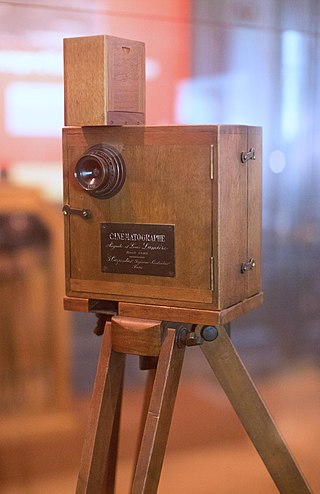
Virtual reality (VR) is a simulated experience that employs 3D near-eye displays and pose tracking to give the user an immersive feel of a virtual world. Applications of virtual reality include entertainment, education and business. VR is one of the key technologies in the reality-virtuality continuum. As such, it is different from other digital visualization solutions, such as augmented virtuality and augmented reality.

Stereoscopy is a technique for creating or enhancing the illusion of depth in an image by means of stereopsis for binocular vision. The word stereoscopy derives from Greek στερεός (stereos) 'firm, solid', and σκοπέω (skopeō) 'to look, to see'. Any stereoscopic image is called a stereogram. Originally, stereogram referred to a pair of stereo images which could be viewed using a stereoscope.
3D films are motion pictures made to give an illusion of three-dimensional solidity, usually with the help of special glasses worn by viewers. They have existed in some form since 1915, but had been largely relegated to a niche in the motion picture industry because of the costly hardware and processes required to produce and display a 3D film, and the lack of a standardized format for all segments of the entertainment business. Nonetheless, 3D films were prominently featured in the 1950s in American cinema, and later experienced a worldwide resurgence in the 1980s and 1990s driven by IMAX high-end theaters and Disney-themed venues. 3D films became increasingly successful throughout the 2000s, peaking with the success of 3D presentations of Avatar in December 2009, after which 3D films again decreased in popularity. Certain directors have also taken more experimental approaches to 3D filmmaking, most notably celebrated auteur Jean-Luc Godard in his film Goodbye to Language.

A stereoscope is a device for viewing a stereoscopic pair of separate images, depicting left-eye and right-eye views of the same scene, as a single three-dimensional image.

A 3D display is a display device capable of conveying depth to the viewer. Many 3D displays are stereoscopic displays, which produce a basic 3D effect by means of stereopsis, but can cause eye strain and visual fatigue. Newer 3D displays such as holographic and light field displays produce a more realistic 3D effect by combining stereopsis and accurate focal length for the displayed content. Newer 3D displays in this manner cause less visual fatigue than classical stereoscopic displays.

A head-mounted display (HMD) is a display device, worn on the head or as part of a helmet, that has a small display optic in front of one or each eye. HMDs have many uses including gaming, aviation, engineering, and medicine.

Scott Fisher is the Professor and Founding Chair of the Interactive Media Division in the USC School of Cinematic Arts at the University of Southern California, and Director of the Mobile and Environmental Media Lab there. He is an artist and technologist who has worked extensively on virtual reality, including pioneering work at NASA, Atari Research Labs, MIT's Architecture Machine Group and Keio University.
The Sword of Damocles is widely misattributed as the name of the first AR display prototype. According to Ivan Sutherland, this was merely a joke name for the mechanical system that supported and tracked the actual HMD below it. It happened to look like a giant overhead cross, hence the joke. Ivan Sutherland's 1968 ground-breaking AR prototype was actually called "the head-mounted display", which is perhaps the first recorded use of the term "HMD", and he preferred "Stereoscopic-Television Apparatus for Individual Use."
SIMNET was a wide area network with vehicle simulators and displays for real-time distributed combat simulation: tanks, helicopters and airplanes in a virtual battlefield. SIMNET was developed for and used by the United States military. SIMNET development began in the mid-1980s, was fielded starting in 1987, and was used for training until successor programs came online well into the 1990s.

4D film is a presentation system combining motion pictures with synchronized physical effects that occur in the theater. Effects simulated in 4D films include, but are not limited to, motion, vibration, scent, rain, mist, bubbles, fog, smoke, wind, temperature changes, and strobe lights. Seats in 4D venues vibrate and move during these multisensory presentations.
Morton Leonard Heilig was an American pioneer in virtual reality (VR) technology and a filmmaker. He applied his cinematographer experience and with the help of his partner developed the Sensorama over several years from 1957, patenting it in 1962.

Leonard Lipton was an American author, filmmaker, lyricist and inventor. At age 19, Lipton wrote the poem that became the basis for the lyrics to the song "Puff, the Magic Dragon". He wrote books on independent filmmaking and become a pioneer in the field of projected three-dimensional imagery. Leonard Lipton developed 3D cinema technology that is used in RealD 3D cinemas. His technology is used to show 3D films on more than 30,000 theater screens worldwide.

Immersion into virtual reality (VR) is the perception of being physically present in a non-physical world. The perception is created by surrounding the user of the VR system in images, sound or other stimuli that provide an engrossing total environment.
Virtual Reality Cue Reactivity (VRCR) is a computer-enhanced methodology used to assess behavioral and physiological reactivity to drug and alcohol sensory cues. Studies indicate that cue reactivity—a response to the presentation of various visual, auditory, olfactory, and tactile cues—increases physiological excitement in addicts. VRCR utilizes virtual reality (VR) technology to stimulate cue reactivity in the most efficient and realistic environments possible; the intention being that coping skills can be taught in a contextual scenario that reflect a real world situation. While still in the early stages of development, studies have shown that VRCR is an effective means of generating a craving-inspiring environment that is tempting to a patient suffering from addiction.
Stereoscopic Displays and Applications (SD&A) is an academic technical conference in the field of stereoscopic 3D imaging. The conference started in 1990 and is held annually. The conference is held as part of the annual Electronic Imaging: Science and Technology Symposium organised by the Society for Imaging Science and Technology (IS&T).

Triotech is a manufacturer of out-of-home multi-sensory interactive attractions. Since 2006, TRIOTECH has operated its own studio to develop custom content for its attractions. Founded in 1999, TRIOTECH is a privately held company based in Canada with offices in the US, Europe, and China. with research and development facilities as well as a movie studio in Montreal, Quebec.

Digital scent technology is the engineering discipline dealing with olfactory representation. It is a technology to sense, transmit and receive scent-enabled digital media. The sensing part of this technology works by using olfactometers and electronic noses.

The history of film technology traces the development of techniques for the recording, construction and presentation of motion pictures. When the film medium came about in the 19th century, there already was a centuries old tradition of screening moving images through shadow play and the magic lantern that were very popular with audiences in many parts of the world. Especially the magic lantern influenced much of the projection technology, exhibition practices and cultural implementation of film. Between 1825 and 1840, the relevant technologies of stroboscopic animation, photography and stereoscopy were introduced. For much of the rest of the century, many engineers and inventors tried to combine all these new technologies and the much older technique of projection to create a complete illusion or a complete documentation of reality. Colour photography was usually included in these ambitions and the introduction of the phonograph in 1877 seemed to promise the addition of synchronized sound recordings. Between 1887 and 1894, the first successful short cinematographic presentations were established. The biggest popular breakthrough of the technology came in 1895 with the first projected movies that lasted longer than 10 seconds. During the first years after this breakthrough, most motion pictures lasted about 50 seconds, lacked synchronized sound and natural colour, and were mainly exhibited as novelty attractions. In the first decades of the 20th century, movies grew much longer and the medium quickly developed into one of the most important tools of communication and entertainment. The breakthrough of synchronized sound occurred at the end of the 1920s and that of full color motion picture film in the 1930s. By the start of the 21st century, physical film stock was being replaced with digital film technologies at both ends of the production chain by digital image sensors and projectors.

A stereoscopic video game is a video game which uses stereoscopic technologies to create depth perception for the player by any form of stereo display. Such games should not be confused with video games that use 3D game graphics on a mono screen, which give the illusion of depth only by monocular cues but lack binocular depth information.

Up Denali 3D is a stereoscopic (3D) documentary directed and produced by Thomas Riederer PE. The film portrays an adventure trek and technical summit climb of Denali, which is also known as Mount McKinley, the highest mountain in North America. Denali has an altitude of 20,320 feet and is one of the Seven Summits of the World. Situated in Alaska, in Denali National Park and Preserve near the Arctic Circle, a June Denali climb is spent without darkness. The sun does not set all month. Due to high altitudes and lower temperatures from the mountain being closer to the North Pole, the entire climb is spent on snow.













